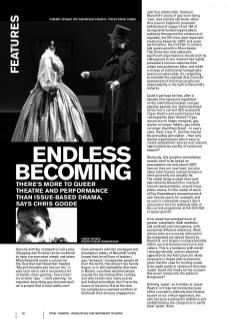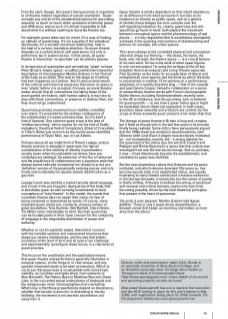Anyone with the chutzpah to call a play Shopping and Fucking can be reckoned to have a provocative streak: and when Mark Ravenhill wrote a column for the Guardian last November headed ‘My pink fountain pen has run dry’, it was hard not to see it as merely a bit of impish chain-yanking. ‘Every time I try to write “gay”, I start yawning,’ he reported, describing gay-focused work as ‘a project that is now totally over’.
Even someone with the privileged and prestigious status of Ravenhill surely knows that for millions of lesbian / gay / bisexual / transgender people all over the world, that project has barely begun, or is still impossible; that even in Britain, countless isolated people outside the big metropolitan centres, and who knows how many scared and bullied schoolkids, don’t have the luxury of his ennui. But at the time his complacency seemed worthier of dismissal than anxious engagement.
Just four weeks later, however, Ravenhill’s sense of gay work being ‘over’ was entirely reframed, when Arts Council England’s proposed withdrawal of support from 194 of its regularly funded organisations suddenly threatened the existence of, arguably, the UK’s two most important producing bases for LGBT and queer performance: the Drill Hall in London, and queerupnorth in Manchester. That these two internationally significant organisations should both be endangered at one moment has rightly provoked a furious response from artists and audiences alike: and while a charge of institutional homophobia seems unsustainable, it’s compelling to consider the regional Arts Councils’ assessment of these key producers’ dispensability in the light of Ravenhill’s remarks.
Could it perhaps be that, after a decade of progressive legislation on the mainstream lesbian and gay equality agenda, the ‘distinctiveness’ (to borrow a current ACE buzzword) of gay theatre and performance has consequently been diluted? If gay voices are no longer marginal, gay stories no longer hidden, gay artists no longer disenfranchised – in every case, that’s a big ‘if’, but that may be the prevailing perception – then why should organisations which exist to create sympathetic spaces and relevant opportunities be worthy of continued support?
Obviously, this question immediately reveals itself to be based on assumptions not only about LGBT lives as they are now lived, but also about what theatre and performance more generally are actually for. The model being evoked here (and described by Ravenhill) is one built around representation, around issuedriven drama. It’s the model of much of Gay Sweatshop’s pioneering work over twenty years, for example: and as such it commands respect. But it accounts in fact for relatively little of the current programme at the Drill Hall or queerupnorth.
In its stead has emerged work of greater complexity (both aesthetic and political) and variousness, with somewhat different ambitions. Work whose aims are scarcely reflected in the exhausted narratives limned by Ravenhill, and largely incomprehensible within our arts bureaucracy’s tick-box culture. This is a tendency with which I strongly identify, and my absolute opposition to the Arts Council’s idiotic proposals is tinged with excitement, given that the case for funding needs to be made partly in relation to this new model. Could this finally be the moment that queer moves into the political foreground?
Defining ‘queer’ as it relates to ‘queer theatre’ is tricky not merely because of the concept’s relatively short history as part of our critical apparatus, but also because evading the definitive and problematising the categorical is partly what ‘queer’ does.
From the start, though, let’s assert that queerness is important to all theatre makers regardless of sexual orientation. ‘Queer’ exceeds any and all of the standardised options for describing sexuality, to touch on much wider questions of identity, power and difference: and as such, it’s almost impossible to talk about what it is without seeming to describe theatre too.
For example: queer takes two (or more). It’s a way of looking, an attitude of questioning. It’s not a quality of the individual; like theatre, it’s a socially construed relationship, held in the heat of a curious, inquisitive attention. So queer theatre depends on a certain level of self-awareness, not only in performers but in audiences too. In that sense, all queer theatre is interactive: no spectator can be entirely passive.
In its rejection of assumption and normativity, ‘queer’ echoes Peter Brook’s ‘empty space’, or LeRoy Leatherman’s beautiful description of choreographer Martha Graham, in his Portrait of the Lady as an Artist: ‘She took to the stage as if nothing had ever happened on it before.’ But it’s also acutely aware of the cultural and historical pressures that mean no space is ever ‘empty’ before it is occupied. It knows, as every theatremaker should, that all conventions (including those of the avant garde) are fictions, with human authors; it may love to play with those conventions, or preserve or destroy them, but they must not go unexamined.
Queerness promotes movement over stability, mutability over stasis. It’s propelled by the restless contingency of the relationships it creates and describes. So it is itself a kind of liveness. One common queer trope is the idea of ‘endless becoming’: which evokes for me the kind of fluidly metaphoric theatrical field of Complicite’s Street of Crocodiles or Filter’s Water just as much as the overtly queer-identified performance of Taylor Mac, say, or Lee Adams.
Perhaps above all we might think of Robert Lepage, whose theatre practice is steeped in queerness: his topical consideration of the volatility of identity in postmodern society (even when his ostensible narratives have precontemporary settings); his extension of the flux of rehearsal and the playfulness of collaboration into a signature style that always seems radically unresolved; his refusal to arrive at a ‘definitive’ version of his perpetually evolving pieces; and only finally and incidentally his (quietly stated) identification as a gay man.
Lepage’s work also exhibits a vigilant anxiety about language, and a trust in the pre-linguistic expressivity of the body, that is absolutely queer as well as being fundamental to most conceptions of ‘total theatre’. In this model, the events that constitute theatre dare not speak their name, for fear of being contained or determined by words. Of course, many important queer artists are, contrarily, virtuosic writers or great storytellers: Tony Kushner, Neil Bartlett, Claire Dowie, Tim Miller come immediately to mind. But their queerness can be located partly in their close concern for the complicity of language in the inequitable distribution of power and authority.
Whether or not it’s explicitly stated, that kind of concern with the invisible systems and unexamined structures that shape our various relationships, and the way that artistic innovation at the level of form and structure can challenge and experimentally reconfigure those forces, is a vital tenet of queer practice.
This focus on the unorthodox and the exploratory means that queer theatre and performance generally flourishes in marginal spaces, on the fringe or in club venues, and any upscale movement tends to be seen as transitory. Which is not to say that queerness is incompatible with mainstream visibility: as countless examples show, from elements of Alan Bennett’s The History Boys or Matthew Bourne’s Swan Lake, to the concerted sexual ambivalence of boybands and the vertiginously ironic choreographies of pro-wrestling. What’s key is that these presentations depend on dissonance, whether that tension is anarchic or dissenting or merely titillating: the movement is not towards assimilation, but away from it.
Queer theatre is wholly dependent on that inbuilt dissidence, on its difference from what surrounds it; but also on its insistence on theatre as public space, and on a politics of identity that privileges the civic complex over the self-regarding individual. So, clearly, queerness and sitespecificity go hand-in-hand: both explore the movement between conceptual space and the phenomenology of real places — a tricky negotiation that is nonetheless exemplarily achieved in the queering interventions of skateboarding and parkour, for example, into urban spaces.
This return always to the contested physical and conceptual sites that shape our thinking — the street, the home, the body, and, not least, the theatre space — is a crucial feature of my own work. So too is the work of other queer figures. In one current project I’m using the writings of the all-butforgotten American essayist and Living Theatre associate Paul Goodman as the basis for an exploration of (literal and metaphorical) room-spaces and the limits by which the body is constrained; in another, I’ll be working on a performance adaptation of a notably dissident blog — that of the novelist and poet Dennis Cooper, himself a collaborator on a series of extraordinary theatre works with French choreographer Gisèle Vienne, including Kindertotenlieder, recently seen in the UK at nottdance, and the upcoming Jerk, scheduled for queerupnorth — to see how a queer online space might be translated into its theatrical equivalent. In both cases, questions about sexuality and eroticism are central, but the scope of these avowedly queer projects is far wider than that.
The lineage of queer theatre in Britain is long and complex but it feels as though only in the last few years is its promise finally being realised. Some critics have persuasively argued that the 1950s theatrical revolution spearheaded by John Osborne (with Look Back in Anger) was decisively motivated by – not homophobia, exactly, but – a strong distaste for the queerness of the status quo, the world of Coward and Rattigan and Binkie Beaumont; a sense that that culture was estranged from real life and social change. And so, perhaps, it was – it had disastrously become the establishment, and inevitably its queerness stultified.
But the new playwriting culture that Osborne and his peers instituted, and which remains dominant fifty years on, has become equally stale in its established status, and equally frustrating to many theatre artists (and a massive audience) in the last two decades; it will persist, but the centre of gravity is finally shifting. A theatre of endless becoming, of perpetual self-renewal and critical liveness, seems only now to be becoming possible, driven by the total theatrical principles that pulsate in the heart of queerness.
‘No artist is ever pleased,’ Martha Graham told Agnes deMille: ‘There is only a queer divine dissatisfaction; a blessed unrest that keeps us marching and makes us more alive than the others.’
Director, writer and performance maker Chris Goode is an associate researcher at Rose Bruford College, and an Artsadmin associate artist. He blogs about theatre at Thompson’s Bank of Communicable Desire (http://beescope.blogspot.com), where details of his current and upcoming projects can also be found.
Stop press! Queerupnorth has won a reprieve from execution and has ACE funding in place for this year’s festival in May 2008, with negotiations taking place for 2009 onwards. For full programme details see www.queerupnorth.com


